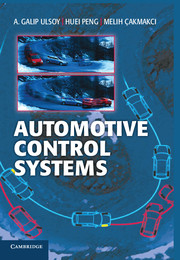Book contents
- Frontmatter
- Contents
- Preface
- Part I Introduction and Background
- Part II Powertrain Control Systems
- 6 Air–Fuel Ratio Control
- 7 Control of Spark Timing
- 8 Idle-Speed Control
- 9 Transmission Control
- 10 Control of Hybrid Vehicles
- 11 Modeling and Control of Fuel Cells for Vehicles
- Part III Vehicle Control Systems
- Part IV Intelligent Transportation Systems
- Appendices
- Index
- References
10 - Control of Hybrid Vehicles
Published online by Cambridge University Press: 05 June 2012
- Frontmatter
- Contents
- Preface
- Part I Introduction and Background
- Part II Powertrain Control Systems
- 6 Air–Fuel Ratio Control
- 7 Control of Spark Timing
- 8 Idle-Speed Control
- 9 Transmission Control
- 10 Control of Hybrid Vehicles
- 11 Modeling and Control of Fuel Cells for Vehicles
- Part III Vehicle Control Systems
- Part IV Intelligent Transportation Systems
- Appendices
- Index
- References
Summary
Hybrid vehicles, especially hybrid electric vehicles (HEVs), demonstrate significant potential in reducing fuel consumption and exhaust emissions while maintaining driving performance. Hybrid vehicles are equipped with more than one power source, and at least one should be reversible. The reversible power source serves as an energy storage device, whereas the other power source is either the primary power source or a “range extender.” Most hybrid vehicles use a battery as the energy buffer, in which case they are known as HEVs. They can be classified as series, split, and parallel hybrids (Figure 10.1). The performance potential of the different configurations and the associated control problems are quite different.
The lower fuel consumption of a HEV typically is the result of several design features: (1) right sizing of the prime mover (i.e., internal combustion engine [ICE]); (2) load-leveling and engine shutdown to avoid inefficient engine operation; (3) regenerative braking; and (4) enhanced CVT function in certain configurations (i.e., series and split). Due to the multiple power sources and the complex configuration and operation modes associated with them, the control strategy for a hybrid vehicle is more complicated than for an engine-only vehicle. This chapter focuses on the design of control algorithms for series, parallel, and split hybrid vehicles. However, we first discuss the layout and pros and cons of the three configurations.
- Type
- Chapter
- Information
- Automotive Control Systems , pp. 148 - 186Publisher: Cambridge University PressPrint publication year: 2012

